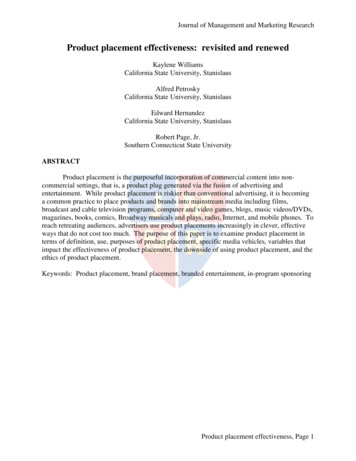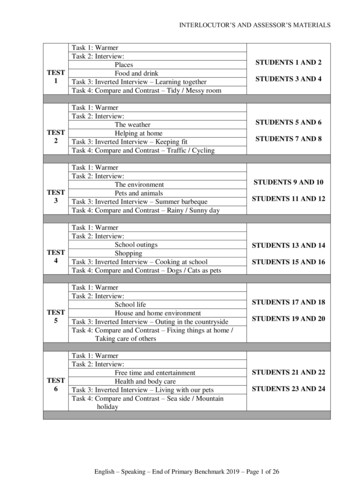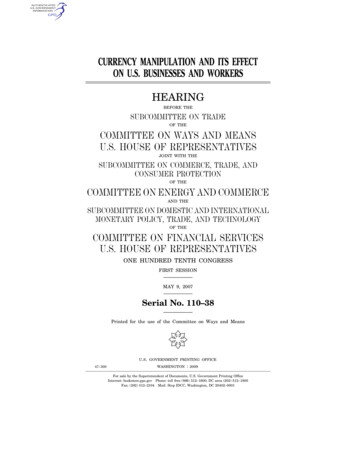
Transcription
International Journal of Jaina Studies 13, 1 (2017) 1-72NĀTH AND DĀDŪPANTHĪ CRITIQUE OF JAINSMonika Horstmann1. Critique of Jains in vernacular religious literature1In northern Indian vernacular literature of the early modern period ideological difference andrivalry between religious groups were articulated in a number of literary forms. Especially threeof these come to mind, namely, debate on doctrinal differences, hagiography, and blame. Whilethe various forms may blend, they are usually distinguishable as trends and more often than notby their stereotypes. This paper focuses on blame, which castigates deficits of the other andpronounces moral claims that the author explicitly or implicitly sees fulfilled in his own group.Blame has a cousin in the genre of instruction to one’s disciples, for teachers point to badexamples. Both, blame and instruction, may also be articulated in the same composition. Bothagain are related to other literary forms, such as formal catalogues of religious prescriptionsand proscriptions. Vernacular literature shares this with its Prakrit and Sanskrit ancestors.Blame is strongly stereotyped which makes it hard, if not hazardous, to extrapolate from acomposition heaping blame on adversaries to social reality. Compositions articulating blameoften appear as satire, which in visual representation has a counterpart in caricature (Habighorst2012).The acid quality of literary blame may obfuscate that it can hardly be taken to fullyreflect the relations between rival groups. Harsh criticism and more conciliatory forms ofcontact may very well coexist and take each their own course.2This paper focuses on the critique of the Jains as articulated by two authors and firstcirculated in Rajasthan. One is a Nāth, named Prithīnāth, and the other a Dādūpanthī by thename of Rajab. The Nāth composition may be from the sixteenth century, while the Dādūpanthīone is from the seventeenth. While they have for their target the Jain sādhus, notablyŚvetāmbara sādhus, the Dādūpanthī text makes also swipes at the Jain laity, seen to be dupedby the sādhus or duping one another. Both texts are written in a variant of western Hindi in1I was stimulated to write this article by John Cort’s (2015) article “Jain Perceptions of Nāth and Haṭha Yogīs inPre-Colonial North India” and by the oeuvre of Prithīnāth which I am currently editing. I wish to thank John Cortand Jérôme Petit for painstakingly commenting on an earlier shorter version of this paper, and Eva de Clercq, PeterFlügel, Anand Mishra, Rahul Bjorn Parson, Jaroslav Strnad, and Minyu Zhang for crucial comments.2For which see section 4.1
which Braj Bhāṣā, the eastern Rajasthani, and proto-Khaṛī Bolī Hindi blend. Prithīnāth’s text ishere edited and translated for the first time, while Rajab’s is translated for the first time.In early modern Rajasthan, all the three mentioned religious groups were powerful. TheJains had been been established in western India since ancient times and with a number of wellconstituted branches, while little is known of the social organization of the Nāths, whocomposed the vernacular texts preserved in manuscripts from the seventeenth century. Inwestern India, however, the symbiosis of Jains with Nāths can be traced back to ancient times,with Jain sacred places often occupying the same space as Nāth sites or superseding these.Illustrative of this is the fact that both Nāths and Jains claim Pṛthvīnātha and Neminātha as theirancestors (White 1996: 119). Three facts about the Nāths of the early modern vernaculartradition can be taken as established. One is that all of them shared in a long-standing religiousand literary tradition which is evidenced by the great uniformity of the topics, style andterminology of their works. Another is that they were adherents of a religion that put emphasison the interior journey leading to liberation in the esoteric body and being supported by theyogic practice of breath control. Conversely, they rejected exterior emblems of Nāth yogisfollowing another tantric tradition of physical practice and emphasizing feats performedallegedly thanks to supernatural powers. The third fact is that all those Nāths have an affinityto the bhakti religion as it was propagated by the Sants. Nāths are more often than not definedas Śaivas. This is no longer tenable for the Nāths appearing as authors of the vernacularcompositions. Their tradition reveals no doubt Śaiva roots, and its yogic terms reflect this: Śivais the supreme self integrating the individual self; the state of supreme perfection is the unionof Śakti and Śiva, and in the topography of the esoteric body this is located at Śivapurī orKailāsa. In its devotional thrust, however, the Nāth tradition of the vernacular texts hardly anylonger relates to sectarian Śaivism. The supreme Self is often named Nirañjana, a termconverging with Sant terminology. H.P. Dvivedī (NSB, p. 19) aptly stated that the variousbranches of Nāthyoga that were allegedly started by Gorakṣanātha comprised all sorts ofreligions, which all shared the commitment to yoga.In Rajasthan, manuscripts of Sant literature have been preserved from about the turn ofthe seventeenth century. Up to the eighteenth century, Sant manuscripts were in their greatmajority Dādūpanthī manuscripts.3 In these, by an often hierarchically arranged sequence oftexts and by express reference to Nāths in individual compositions, these figure as reveredforebears of Dādū and his followers. Not the Nāths, whose state of constitution as an order atthat time is quite unclear, but the Dādūpanthīs were the first to disseminate both entire corporaof vernacular Nāth literature together with Dādūpanthī and other bhakti literature, notably inone and the same manuscript. The most famous among these Nāth works first transmitted by3The Sikh tradition is ignored here.2
the Dādūpanthīs is the Hindi Gorakh-bānī (GB). There prevails thus an interdependencebetween Nāths and Dādūpanthīs. Like that of all other Sants, the Dādūpanthīs’s bhakti rests onthe Nāth tradition, while the Nāth tradition of the vernacular compositions as they appear firstin Dādūpanthī manuscripts represents an accommodation to Sant bhakti.The frictions between the groups that triggered blame from the pen of Nāths andDādūpanthīs arose from social and religious differences. Numerous of these are clearlyreflected in the texts under review and will be discussed below. Broadly speaking for the caseof Jains and Dādūpanthīs, a shared trading caste constituency and thereby rivalry for patronage musthave been a social cause of friction. For rivalry between Jains and Nāths, this may have developed asa general stance in the course of their shared ancient history. With so little known about theorganization of the Nāths who produced vernacular literature in the period prior to theseventeenth century, acute cases of social friction between these and the Jains cannot be pointedto at the present state of research.Jain traders and money-lenders enjoy a broadly shared bad reputation for their greedand lack of commiseration with the poor.4 While this does echo in Rajab’s text, it is not in thefocus of either of the texts, which address the vices of mendicants rather than laymen.Explaining the relationship between Jains, on the one hand, and Nāths and Dādūpanthīs,on the other, as a dichotomy between upper versus lower castes remains inexhaustive. Jains areof course dominated by a trading caste constituency, while Nāths and Dādūpanthīs jubilantlyboast of their social inferiority and rejection of orthodox Hindu mores. Moreover, to distinguishthem further from the Jains, if not in terms of high versus low, there were both Nāth andDādūpanthī Muslims. As for “inferiority” or being “low-caste,” however, this is paraded byboth Nāths and Sants as a badge for eligibility for salvation. It is deceptive to identify thisstraightaway with social identity. For the Dādūpanth, we know that in the first century of itsexistence, its constituency comprised Hindus and Muslims and castes ranging from Brahmansto artisans. Both the Nāths and the Sants possess impressive literary traditions, and of theDādūpanthīs we know that scribal skills were also the property of sādhus from other than thetypical scribal groups, such as Brahmans, Kāyasths and traders. The oldest availableDādūpanthī manuscript, for example, was scribed by a Jāṭ (Strnad 2016: 562). Caste did notautomatically determine the intellectual and social parameters of the personalities that shapedthe Nāth or Sant religious culture.The two texts targeting the Jain mendicants come from the milieu of religiousspecialists. Prithīnāth may or may not have been a sādhu, but took great pains to set off theideal sādhu from the religious fraud. This concern runs through his entire oeuvre. The very termsādhu need not be limited to a monk but can also refer to the ideal devotee regardless of his4For the position and reputation of Jain traders as usurers, see Hardiman 1996a and 1996b; compare also p. 12.3
station in life. The doctrine and practice Prithīnāth expounds in his verse treatises may haveconcerned the sādhu in the technical sense of the word rather than the layman. Prithīnāth’soeuvre was transmitted first and perhaps exclusively in the monastic tradition. For Rajab, hewas a direct disciple of Dādū and a monk.5 The circulation of both texts must have been limitedto relatively narrow sectarian confines. As a part of his collected works, Prithīnāth’s text madeit into Dādūpanthī manuscripts, but so far has not been traced outside of these.6 Rajab’s textseems not to have been circulated in manuscripts outside of the Dādūpanth. While at leastPrithīnāth rhetorically turns to the Jains, Rajab expressly addresses a Sant audience. I wouldargue that their critique of the Jains was intended by both authors to admonish their owndisciples not to stray from the path laid out for them by their gurus. The Jains served as thenegative foil on which the Nāths’ and Dādūpanthīs’ religious righteousness was projected.Blame, satire, and slander lend themselves to present oneself in the brightest light so that theother is blackened by the darkest shadow. In a striking manner they emphasize sectarian bonds,boost the morale, or at least provide entertainment. Religious blame is an age-old genre and itsevergreen popularity calls for repetition, perhaps also without imminent cause. A sādhu of someliterary aspiration would not only learn how to compose distichs and songs, but also texts of“instruction” (upadeśa) and, its cousin, blame.Nāths and Sants shared in the pursuit of brahman-gnosis and accordingly demanded thatthe seeker revert his attention from the world to the interior. They rejected the religious normsof orthodox Hinduism (varṇāśrama-dharma), and replaced them by their own norms. To them,orthodox religious norms and practice were pointless if the practicioners of these lacked the oneessential property: insight into brahman. Proper insight would reveal that the superior Self andthe self were one. The Nāths’ and Sants’ commitment to nondualism clashed with the principlesof Jain religion. According to them, the Jains hold false ideas and are notorious hypocrites,because they do not go by the compass of brahman-gnosis. As has been pointed out by PaulDundas (2001: 231f.),[e]xtreme forms of behavior indicating an attempted direct engagement with somevariety of unconditioned or unmediated reality seem to have been advocated only within thoseSouth Asian traditions that had nondualism as an ideological basis. The Jains, pluralist realiststhroughout their intellectual history, have consistently rejected nondualism and itsphilosophical affine, monism, whether of Hindu or Buddhist provenance, as equivalent toidealism.5See section 3.1.6I speculate that the manuscripts on which NSB is based are Dādūpanthī ones, too. Access to these is currentlyimpossible.4
The texts of Prithīnāth and Rajab are cases in point of this doctrinal differenceaggravated by social issues.1.1. Religious blame: A cliché and its early modern variantsNāths and Sants were derisive of the representatives of the sum total of religions beyond thepale of their own creeds. According to them, those religions were represented by a bunch offools and hypocrites. The totality of religious systems they called the “six religions,” literallythe “six views” (ṣaṭa darasana), a term reminiscent of the conventional list of six majorphilosophical systems, but not identical with these.7 When enumerated, the items of the list arefound to vary, but Jain mendicants are never missing. In his Bhaktamāl (1660), the Dādūpanthīhagiographer Rāghavdās is seen to use the rubric ṣaṭa darasana to comprise saṃnyāsīs, Nāthyogīs, Buddhists - though in fact he only mentions the Buddha - , jaṅgamas, Jains, and śaikhs(Muslims).8 In Rajasthan, the term “six views” for the totality of religions was so common thatit it figured in the designation of an office and in a religious title. In Mewar, the office in chargeof religious institutions was designated as the “office of the six views,” and, for example inJaipur, the honorary title “king of kings of the six views” conferred upon a high-rankingreligious dignitary.9There was a minimal cliché that captured the “six religions,” and this could beelaborated on in endless variation, often to remarkable satirical effect (Horstmann 2012). Twoinstances of this, one from a Nāth and the other from a Dādūpanthī author, will do forillustration:Prithīnāth (16th century) says,10Forming ideas on the six religions and six learned menThe days pass by.7In his Ṣaḍ-darśana-samuccaya, Haribhadrasūri (9th cent.; SDS) discusses the Bauddha, Naiyāyika, Sāṃkhya,Jaina, Vaiśeṣika, and Jaiminīya (Mīmāṃsā) philosophical systems. Another traditional list of the six systemscomprises Mīmāṃsā, Vedānta, Sāṃkhya, Yoga, Nyāya, and Vaiṣeśika.8Rāghavdās completed his hagiography in 1660, but all the versions that have come down to us show incisivechanges made from 1800 by commentators and later redactors. Therefore also the rubric ṣaṭa darasana can nottaken beyond doubt as part of the original. In some versions, the last two of the six are missing so that they wererelegated by the modern editor to an appendix (RBhM-Nah).9For the office, see Clémentin-Ojha (forthcoming). For the title, this was, for example, accorded to the Rāmānandīmahant Bālānand of Jaipur (mahant 1752–1797).10In the original, ṣaṭa darasana ṣaṭa sāstrī/ina kauṃ kalapatahīṃ dina jāṃhi (cited according the oldest availablemanuscript of the compositions of Prithīnāth, dated 1615; for a variant reading, see NSB, p. 77).5
And Dādū (d. 1603) says,11Yogīs, jaṅgamas, sevaṛās, Buddhists, saṃnyāsīs amd shaikhs,In the absence of Rām, Dādū, the six religions are garbs of fraud.This cliché and variants of it had come down to the Nāths and Sants from varioussources, which spanned the oral and written tradition. The more or less flexible cliché that wefind in vernacular literature can for example be traced back to a passage in Bāṇa’s Harṣacarita(7th cent.). That passage cannot be broken down to the grid of a cliché but is at least reminiscentof the frozen popular cliché. The same passage may also go some way to explain the transitionfrom “six views” to “totality of religions.” Bāṇa describes a motly crowd of holy men andcontrasts this with the equipoise of the serene Buddhist monk Divākaramitra. This descriptionhas the satirical potential often found exploited in the cliché relating to ascetics as we find it invernacular Nāth and Sant literature. In the relevant passage, the holy men are thronging toreceive instruction from Divākara, and King Harṣa also goes to meet him (HC-CT, pp. 235-37):Then in the middle of the trees, while he was yet at a distance, the holy man’s presencewas suddenly announced by the king’s seeing various Buddhists from various provincesseated in different situations, - perched on pillars, or seated on the rocks or dwelling inbowers of creepers or lying in thickets or in the shadow of the branches or squatting onthe roots of trees, - devotees dead to all passion, Jainas in white robes, whitemendicants,12 followers of Kriṣṇa, religious students, ascetics who pulled out their hair,followers of Kapila, Jainas, Lokāyatikas, followers of Kaṇāda, followers of theUpaniṣads, believers in god as a creator, assayers of metals, students of legal institutes,students of the Purāṇas, adepts in sacrifices requiring seven ministering priests, adeptsin grammar, followers of the Pañcarātra and others besides, all diligently following theirown tenets, pondering, urging objections, raising doubts, resolving them, givingetymologies, disputing, studying, and explaining, and all gathered here as his disciples.11In the original, jogījaṅgama sevaṛe, bauddha saṁnyāsī śekha/ṣaṭ darśana dādū rāma binā, sabai kapaṭa kebhekha (DB, sākhī 14.33).12The original of the passage translated as “devotees dead white mendicants” reads, “ vītarāgair ārhatairmaskaribhiḥ śvetapaṭaiḥ pāṇḍurabhikṣubhir bhāgavatair varṇibhiḥ keśaluñcakaiḥ ˮ: “ passionless followersof the Arhats, Maskarīs, Śvetapaṭas, Pāṇḍura mendicants, Bhāgavatas, Varṇīs, those who pull out their hair ”(HC, pp. 422-23).6
In the cited passage, Jains are mentioned as wearers of white robes (śvetapaṭa) andthereby identifiable as Śvetāmbara sādhus,13 and as those who pull out their hair, but they arealso ranged more specifically with followers of particular philosophical tenets. They form afluid rather than a systematically defined category. Another feature of the quoted passage is thatit distinguishes between categories of seekers of instruction: One is that of ascetics, another thatof philosophers, yet another that of a variety of specialists like assayers of metals and so forth,and finally one of the specialists of various ritual systems. The passage indicates that ratherthan to systemize, the aim of Bāṇa was to emphasize an abundance of religious styles. Theexpression of abundance, more often than not satirized as an abundance of follies, has remainedthe chief function of the corresponding cliché that we find in vernacular religious literature.Interesting in the cited passage is the mentioning of the representatives of particular religiousphilosophical systems, for the description of their category may have formed one among thetrajectories along which the term “six views” became a short-hand term for “all religions.”More than any other tradition, the tantric tradition of the Siddhas as it is represented bythe authors united in the Apabhraṃśa Dohākośa and Caryāgītikoṣa is fundamental to both Nāthand Sant literature. 14 This is not to say that those Apabhraṃśa works are related to theseliteratures by a lineal genealogy. First of all, the Siddhas’ identity is elusive; secondly, Nāthsand Sants name as Nāth Siddhas hardly any of the authors known from those two works butrecognize as their own masters and spiritual ancestors, respectively, an additional number ofNāth Siddhas of a later period, and, thirdly, the authorship of the compositions in both theApabhraṃśa works and the vernacular Hindi tradition is ascribed rather than factual, andascriptions to authors are also floating. 15 The nine Nāth Siddhas mentioned in vernaculargenealogies have been attested since about the thirteenth century, but besides these, many moreNāth Siddhas are mentioned in Hindi texts (White 1996: 92f.; NSB: 3–5). The floating traditionof couplets and songs lent itself to being connected with the great names of the past or wasindeed adapted to their own needs by individual vernacular Nāth authors. The reason why thevenerable figures of the past were conjured up to authenticate much younger vernacularcompositions must probably be sought in the evolution of distinct lineages in their name thatbecame ultimately known as the Twelve Paths of the Nāths.In the Dohākośa, Saraha is the author whose religious critique is most expansive andrepresents a template, whose author he may not have been, but which runs through all13On the specific meaning “Śvetāmbara”, see Jaini 2008: 13, 15.14For translations, see DK and CG.15For various lists of Siddhas and Nāth Siddhas, see White 1996: 81-6.7
subsequent literature, both vernacular and Sanskrit. According to Roger R. Jackson (Dohākośa,p. 19),[i]n the first fifteen verses of his Treasury, Saraha takes on, in succession, brahminritualists , who are denounced for their pointless recitations and sacrifices; mendicantascetics , who are mocked for their deceit, hypocrisy, and greed; Jain renouncers ,who are ridiculed for their obsession with physical austerities; Buddhist monastics ,who are chastised for their dress-up games, their intellectualism, and their attempt todesiccate the mind through meditation; Mahāyānists , who are described as sophistsand verbal gymnasts; tāntrikas , who are said to be obsessed with mantras, maṇḍalas,and mystic initiations; and practitioners of all kinds .In verses 6–9, Saraha lampoons the Jains, in the original named khavaṇa (DK, pp. 55-6):The long-nailed yoginlooks filthy,16goes naked,pulls out his hair by the roots.Jains mock the pathby the way they look;they deceive themselvesin teaching freedom. (6)If going naked means release,then the dog and the jackalmust have it;if baldness is perfection,then a young girl’s bottommust have it. (7)If flashing a tail means freedom,then the peacock and yakmust have it;if leftover food turns to wisdom,16This age-old stereotype has a delightful variant in Harṣacarita (HC-CT. pp. 134-35): “ straight against him(Harṣa) came a naked Jain, bedecked with peacock’s tail-feathers, a fellow all lampblack as it seemed with thecollected filth of many days besmirching his body.”8
then the elephant and horsemust have it. (8)Saraha says:It seems to me for Jainsthere is no freedom:the bodydeprived of the realonly gains isolation. (9)Further on in time, in the mid-sixteenth century, Jāyasī described in Padmāvat (probably 1540–1541) the ideal geography of Siṃhaladvīpa, its flora and fauna, and its holy men (2.30):17At every step there are wells and stepwells, well-made sitting-places, and stairways, (1)As well as many water reservoirs all over, all the pilgrimage places duly named arethere, (2)Monasteries and kiosks have been created everywhere; all religious settlements brimwith muttered prayer and austerities. (3)There are great ṛṣis, saṃnyāsīs, servants of Rām, ascetics holding month-long fasts, (4)There are those who follow the course of perpetual celibacy, and the naked sky-cladones (digambara), (5)There are sarasvatī-siddhas, 18 jogīs, and other renouncers who follow the path ofdisillusionment, (6)17P, p. 34. Translation by the author. The original reads:paiga paiga para kuāṁ bāvarī, sājī baṭaka au pāṁvarī/ (1)auru kuṃḍa bahu ṭhāṁvahiṁ ṭhāūṁ, saba tīratha au tinhake nāūṁ/ (2)maḍha maṃḍapa cahuṁ pāsa saṁvāre, japā tapā saba āsana māre/ (3)koī rikhesvara koi sanyāsī, koi rāmajana koi masavāsī/ (4)koī brahmacarja paṁtha lāge, koi digambara āchahiṃ nāṁge/ (5)koi sarasuti siddha koi jogī, koi nirāsa paṁtha baiṭha biyogī/ (6)koi mahesura jaṃgama jatī, koi eka parakhai debī satī/ (7)sevarā khevarā bānaparastī sidha sādhaka avadhūta/āsana māri baiṭha saba jāri ātamā bhūta// (8)18White 1996: 225–7.9
There are maheśvaras, 19 jaṅgamas, jatis, 20 and those who worship the śakti of theGoddess, (7)sevarās, khevarās, forest-dwellers, siddhas, sādhakas, and avadhūtas, (8)They have burnt themselves and the elements and established their seats there. (9)At about the same time, we find the cliché occurring also in the Ādigranth, where it is, forexample, subtly reworked in Āsā kī vār (AG, Āsā kī vār 6).21With the Dādūpanthīs and other Sants, the cliché functions typically as the opening orcoda of serial compositions denouncing “all religions” from the perspective of superior insight.The Bhrama-vidhvaṃsa-aṣṭaka (Octave on the destruction of error) of Sundardās (according totradition, 1596–1689) is a case in point:22Sundar has observed and probed the knowledge of everyone:As long as he does not contemplate Nirañjana, no one should feel satisfied. (1)I have examined the six religions: the habits of the jaṅgamas, shaikhs, saṃnyāsīs,sevaṛās, paṇḍits, and bhaktas. (2) The follower of the Arhant-dharma is in deep error; he pulls out his hair but is shameless,He craves delicacies, eats sweets, and is under the sway of sex,He sees with eyes of flesh, while a fire burns in him; instead of seizing the essential, hethrows it away.Dādū’s disciple Sundar has dispelled error, and plays in the state of detachment. (5) 19For Māheśvara Siddhas, who were practioners of alchemy, see White 1996: 101-03.20This is an instance of the term jati being used in a wider sense than in the more restricted sense of Śvetāmbaramendicant, the type of Jain sādhus relevant to this article.21Composed by Gurū Nānak and Gurū Aṅgad and thereby not later than 1552, the year of the death of Aṅgad.22SG, pp. 235–38; for this passage, pp. 235f.sundara deṣyā sodhi kaiṃ saba kāhū kā gyāna/koī mana mānai nahīṃ binā niraṃjana dhyāna//1//ṣaṭa darasana hama ṣojiyā yogī jaṃgama śeṣa/sanyāsī aru sevaḍā paṇḍita bhaktā bheṣa//2// tau arahata dharamī bhārī bharamī keśa uparamī beśaramī,jī bhojana naramī ṣāvai ṣuramī manamatha karamī ati uramī/aru dṛṣṭi su caramī antira garamī nāhīṃ maramī gahi ṭhelā,dādū kā celā bharama pachelā sundara nyārā ṣelā//5// 10
In the introduction to his Sarvāṅgayoga-pradīpikā (Light on yoga in all its categories),the same Sundardās reworks the cliché into a virtual carnival of less than wise holy men andreligious styles.231.2. Classes of Jain mendicants mentioned in clichésThe variants of the cliché reviewed above do not provide a rigid typology of Jain mendicantsby their branches. The intent of all authors mentioned was to debunk established religion.Nevertheless, we may sort out more details about those mendicants. Bāṇa’s description “ vītarāgair ārhatair maskaribhiḥ śvetapaṭaiḥ pāṇḍurabhikṣubhir bhāgavatair varṇibhiḥkeśaluñcakaiḥ ,” “ passionless worshippers of the Arhats, Maskarīs, Śvetapaṭas, Pāṇḍuramendicants, Bhāgavatas, Varṇīs, those who pull out their hair ” was commented on byŚaṅkara Kavi (date unknown). He paraphrases ārhatair as “worshippers of the Arhant, nakedkṣapaṇakas,” maskarībhiḥ as “houseless ascetics (parivrājaka),” śvetapaṭaiḥ as “wearing whitewoolen blankets, a particular class of naked kṣapaṇakas” ḥ), pāṇdurabhikṣubhir as “those who are free of defilement,”bhāgavatair as “devotees of Viṣṇu (viṣṇubhaktair),” varṇibhiḥ as brahmacārins(brahmacāribhiḥ) and keśaluñcakaiḥ as “appropriately named ones” (yathārthanāmabhiḥ).According to Śaṅkara, then, the Jain mendicants are naked (nagnakṣapaṇaka), whichcorresponds to Digambaras, or naked kṣapaṇakas wearing white woollen blankets, which ratherpoints to Digambaras distinguished from the stark-naked ones by being wrapped in a whitewoollen blanket.24 The keśaluñcakas derive their name from the characteristic rite of pullingout their hair which would apply to both Digambara and Śvetāmbara medicants.Saraha defines Jain mendicants as naked kṣapaṇakas, that is, Digambaras. Jāyasī speaksof sevarās and khevarās, which corresponds to śvetapaṭas and kṣapaṇakas, whereas in Santliterature we usually encounter sevaṛās and jatis as the representatives of Jain mendicancy.Although yati/jati may denote any ascetic, not only a Digambara or a Śvetāmbara one, the termrefers more specifically to Śvetāmbaras. Yatis/jatis are usually identified with Śvetāmbaramonks descended from temple-dwelling sādhus (Dundas 2002: 152, 136-38). Rarely howeverdoes one encounter elaborate Sant critique of these. While digambara ascetics are targeted,these are to be understood as naked ascetics of sorts and not specifically naked Jain mendicants.23V. Ś. Agravāl refers to this in his commentary on P 30.0 (p. 35). For a translation of Sundardās’s text, seeHorstmann 2012. I now consider the argument I made in this publication methodologically flawed in so far as themore ancient cliché furnished descriptions that were carried over from an earlier period and are therefore hardlyadequately interpreted by pointing to cultural features prevailing in the seventeenth century.24On the specific meaning “Śvetāmbara”, see Jaini 2008: 13, 15.11
The samples of critique cited below come from Sant literature dating from around 1600, a timeby which naked Digambara monks had become rare in reality, if not as an ideal.25 By that time,Digambara culture had become chiefly represented by the bhaṭṭārakas, monks of pontificalrank and lifestyle, “wearing orange robes both inside and outside the monastery and taking themoff only when eating or when initiating another bhaṭṭāraka” (Dundas 2002: 124). They seemnot to have formed a focus of Sant critique but can be suspected to have been included in theSant caricatures of luxury-loving monks.26Dādū’s disciple Sundardās (d. 1689), for example, lumps together yatis, Nāths,digambaras, and Jains so that digambara must be taken to mean any naked religious man, whileJains are rather qualified by fancy dress:27By pulling out one’s hair, he does not become a yati; by splitting one’s ears, not a yogī,Sundar says: How will this bring about perfection? For its uselessness it is rather a stockof laughter. (23)Sundar says: There went digambaras dressed in sackcloth,And there were those who had lost their home, donned a tiger skin and turned tigersthemselves. (24)There are Jains, wearing red, yellow, or white robes, or those dyed with cutch,Sundar says: I have seen all those costumes, but nowhere peace of mind. (25)Satire penned by sādhus usually targets the Jain mendicants. Occasionally however onefinds also lay Jains being satirized. One author to be named is Bakhnā, a lay disciple of Dādūwho flourished in the first half of the seventeenth century. He was deft at satirizing in epigramstypes of people or vices. Among these
religions, which all shared the commitment to yoga. In Rajasthan, manuscripts of Sant literature have been preserved from about the turn of the seventeenth century. Up to the eighteenth century, Sant manuscripts were in their great majority Dādūpanthī manuscripts.3 In these, by an often hierarchically arranged sequence of











